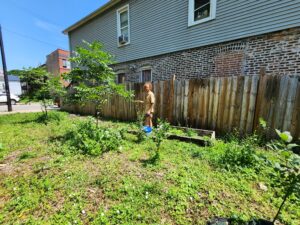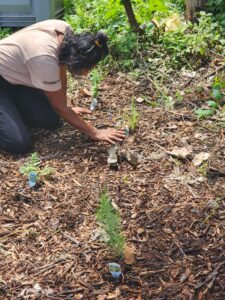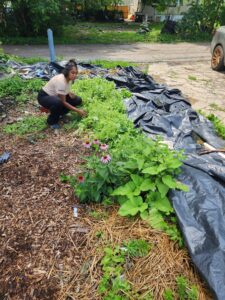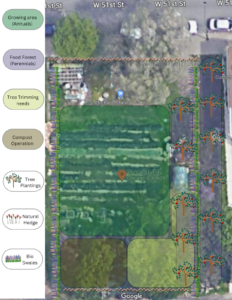Final report for FNC23-1387
Project Information
OTIS Fresh is cooperatively-ran farm in Back of the Yards, a low-income neighborhood on Chicago's south side. Founder Steve Hughes, a life-long neighborhood resident, started the farm through industrial vermicomposting over the 1/4 acre formerly vacant lot in 2017 off of very busy 51st street. The space was had been used as an outdoor annex space for programming by the neighboring #LetUsBreathe collective, a Black liberation organization whose #EverybodyEats initative helps distribute 200 pounds of produce weekly year round. Steve had a stroke in early 2020 and is currently in rehab making slowprogress. Long-time volunteer Mabel(Matthew Norris) took over operations with Pooj after Steve became unable to continue, and we continue to follow his vision to create a replicable model for young people to see farming on the excess of vacant land in the neighborhood as a viable career path. Steve is still an active co-op member.
Through no-dig regenerative growing, we have transformed the plot into fifteen 50' x 3' beds along with a seating area and large farmstand where we do weekly food distribution. If we aren't making sliding scale bags for folks as they pass by, we are filling a solar-powered sidewalk-facing fridge stewarded by #LetUsBreathe. In 2022 we grew over 2,000 pounds of produce, 1/4 of which was donated to community members as part of our inaugural CSA season.
Mabel is founder of Grow-Op Chicago, a marketing and fundraising consultancy that works with BIPOC-led farms and agriculture businesses to capacity build. Their journey started with launching the Home Growers Program, a grant-funded seed starting initiative that mobilizes people to start seeds for community gardens in their own home. Their early experience in urban agriculture was spent leading volunteer coordination and youth programming at Altgeld Sawyer Corner Farm with Christopher House students. They've been content creator and artistic director for agriculture education video projects with Grow-Op for University of Illinois' lead testing research project, AUA's Chicago Urban Agriculture Mapping Project, and for Grow-Op's own farmer interview series. They function as farm director and handle bookkeeping.
Pooj has worked as an organizer for Illinois Solar For All following completing their graduate degree in Environmental Chemistry. They worked on farms in Charlotte where they are from originally, since joining as a worker-owner has take on management of crop planning along with more technical operations. Outside of the farm, they do community organizing with Neighbors For Environmental Justice in the city.
*progress as of 1/29/2025*
Our no-dig operation has expanded to include an additional 5 50'x3' beds, allowing us to grow over 4,000 pounds of produce without any season extension implements on-site. We have effectively maximized our operational efficiency, poising us to add a hoop house to grow year round.
We are trying to create an urban farm cooperative in a high-traffic thoroughfare which transforms a vacant, neglected lot into a bustling community garden that functions as both a source of viable employment and for emergency food distribution to the community. In an urban environment, we are unable to avoid trash blowing into our farm. This is characteristic of disinvested neighborhoods, and we can solve this creatively through planting bioswales, native shrubs, and fruit trees. We also have immense shade due to careless hacking by utility companies over the years, leaving our plot with increasing shade issues due to the way they've grown and a risk of large falling branches. We need an arborist to cut down the trees, which will ensure more consistent crop yields but also allow for us to experiment with native grains as a microbacterial trap in an establishing urban food forest setting.
In order to be profitable, we need a drip irrigation system that can automate the watering process and free us up for other business advancement opportunities. Hand-watering has been standard since 2020, and it is terrible inefficient because we are underutilizing our IBC tote.
*progress as of 1/29/2025*
The bioswale at this point has effectively functioned as a trash collector, and to a smaller degree as a windbreak. After the natives are more established in 2025, we anticipate it becoming an immersive living fence feature. The tree trim allowed substantial more sun into the plot, setting us up for full unobstructed vegetable production into the future. While our assessment on needing the trim was overall correct, we feel it hampered our ability to implement the Indigenous Microorganisms (IMO) process effectively. We still have trees on the perimeter of the plot, but getting rid of the male mulberry and silver maple changed the microclimate enough that it nulled our hypothesis.
For this reason, our educational approach changed to prioritizing our journey navigating agriculture as a cooperative, sharing our incorporation story from vacant lot to a for-profit farm, our profit-sharing model, and speaking to the robust community stakeholder relationship and reciprocal collaborations that have allowed us to grow at a pace consistent with community buy-in. This workshop/Q+A will be hosted throughout 2025, with our first being at 1/30-1/31 at the Chicago Botanic Garden as part of a farmer panel discussion and a cooperative farming how-to workshop.
Our water access issues have limited our ability to prioritize other important growth tasks needed to become sustainable. Implementing an above ground drip irrigation system is crucial to efficiency and uses our new water connection with with our neighbors J+E Glass who we have an Memorandum of Understanding (MOU) with for water use. This includes all emitters, tape, puncturing equipment, 3-4 timers for automation that splits the farm in multiple sections (i.e. daily vs 3 days / week), and an enclosure to protect the timers and the main valve.
For a holistic green space, we believe cultivating a small food forest will satisfy wants from community members that have been expressed. The orchard and native pollinator planting will follow the trimming of our three Siberian Oak trees, and be complemented by bioswales along our landscape perimeter to reduce time spent doing trash collection (normally 3 times/week) and manage stormwater runoff. Pooj will also lead experimentation on harvested cover crops to see if they function as successful traps for beneficial bacteria. This multi-stage process will allow us to see if we can achieve fermentation using native grains in a closed loop in an urban environment. This would function as another way to amend compost piles without bringing in unnecessary inputs.
After the sustainability of regular labor and operational costs are met following this granting period, we plan to reintegrate the educational programming that Steve started back in 2018. We piloted an eight-week after school program with neighboring Richards Academy High School (across the street) consisting of a meal and beginning farming education for students designed by OTIS Fresh founder Steve Hughes. This will be a separate project, but once the farm is set we aim to bring on a dedicated educational program coordinator (fourth worker-member). Additionally, this project will allow for us to return to creating content that mobilizes people to engage with local farms, community gardens, and food access and equity initiatives as Grow-Op was initially intended for. All of these process will be documented and shared to our highly engaged Instagram and on our website that we will be launching this winter.
Objectives:
-Implement above ground drip system for all beds, document installation process and maintenance troubleshooting with videos and journaling
-Hire and on-board third worker-owner as farmhand and delivery support with pathway to farm operations lead
-Diversify crop plan to include 1 full bed of cut flowers, 1 full bed of herbs, leeks, cauliflower, and other high-value crops as per feedback with stakeholders
-Plant an orchard on additional 24' x 100' in understory of soon-to-be-trimmed siberian oak trees
-Secure 1-2 consistent restaurant partners
-Expand CSA to 15 full season commitments
-Share progress and cross promote on social media, website, and newsletter
-Plant three beds of native cover crop (wheat, millet, oats) in August for Korean farming method trials
-Plant 5 varieties of native medium dry soil bioswales
-Develop workshop on navigating water access and building a cooperatively run farm for public presentations
*progress as of 1/29/2025*
Objectives (Updated):
-Implemented above ground drip system for all beds, built rain barrel water collection system with gutter and mesh system on farmstand. Due to J+E Glass no longer operating out of the building, we instead have an MOU with the barbershop neighbors to the East of the farm and run the drip from there.
-Hired and on-boarded third worker-owner as educational lead (Chef Mel Carter) who led recipe demos and teach-ins, and ran farmers market every Saturday
-Hired neighbors on contract for farm hand and delivery support with pathway to farm operations lead and full worker-owner status in 2025 (Florencio)
-Diversifed crop plan to include 1 full bed of cut flowers, 1 full bed of herbs, leeks, cauliflower, and other high-value crops as per feedback with stakeholders
-Planted an orchard on additional 24' x 100' in understory of trimmed trees
-We forwent restaurant partnership until hoop house is built, instead had new worker-owner Chef Mel secure sales relationships with senior housing developments in and around the neighborhood for use of WIC senior voucher program.
-Expanded CSA to 25 full season commitments, not including additional free custom bag delivery/pick-ups week over week
-Shared progress on social media, website, and newsletter
-Planted three beds of native cover crop (rye, foxtail millet, yarrow, plantain) for Korean farming method trials, negligible results, hypothesis not reached
-Planted 5 varieties of native medium dry soil bioswales with success. They are still establishing and will take off in 2025
-Developed workshop on building a cooperatively run farm for public presentations, emphasis on profit-sharing and community stakeholder collaborations
-Hosted 15 cooking demos led by new worker-owner Chef Mel on-site at the farm. OTIS 2024 Events
Relaunching collaboration with Richards Academy is still a year or two out, for now we plan to collaborate with Road to Redeption farm founder Clarence Smith who will utilize the space for workforce development training with previously incarcerated young men from the area.
Cooperators
- - Producer
Research
n/a - to be shared following research component. Below are overlays for what we have done and the intention behind the orchard and swales.
*progress as of 1/29/2025*
KNF Process
A small box was made to place the four native grains/seeds we trialed in the most secluded section of the orchard area near the back of the farm. Seeds were saved in 2023 and full plants were left in tact, cut at the soil level, and bundled in the box. Our plan, if the contents were properly colonized/innoculated, was to use a compost tea aeration process and test the foliar sprays made on 1/4 of each 50' long bed.
Bioswales and orchard planting:
The bioswales featured a mix of self-started seeds (70%) (echinacea, yarrow, mallow, golden rod, phlox, black eyed susan), natives we let grow (10%) (mugwort, burdock, chicory) and nursery bought (20%) (milkweed, side oats grama). We used white plastic followed by black plastic to grow and subsequently kill weeds in the ground to prime the planting area. This included a week of time to let air hit top of soil before transplanting. See descriptions for more insight into process. We will additionally plant some shrubs along the alleyway in the back of the farm to fill in some spots that are rocky with poor grading. Due to expected transplant loss and labor restrictions due to heat of season responsibilities, we recommend doing it one plot at a time. Space restrictions, water pressure shortfall, and farmhand duties kept us from being able to run drip to these far corners of the plot and also properly nurture all plots simultaneously. As these also function as a living fence but still havent established to full size, some neighbors stepped on and stunted different plants in the more walkable areas of the perimeter.




The tree removal cleared space for us to finish the fruit orchard and make room for the 46' x 25' hoop house we will install by mid summer 2025, but we fear it led to negligible bacterial growth for the foxtail millet, plantain, yarrow, and rye trials we did using the KNF process. We harvested in Fall of 2023 and Summer of 2024, with no visible fermentation or fungal mat having formed. It functionally led to no result from our trials running from June through November in 2024. We assess that our production farm and orchard set-up at our scale (quarter acre) is not suitable for a proper KNF project, mainly because of how populated 51st street is and since we removed trees, we've had more neighbors walking through (a good thing). This interupts the natural processes needed to take place for the trials in our opinion.
After two years time, we deem it may be more worth our while to relaunch the IMO trials when the food forest and bioswales are more established, but feel we'd need more acrerage or not to be in such a high-traffic area off 51st street to succeed. This would work better in a peri-urban, rural, or suburban environment with ample space nearby to plant thickets of native plants. There are other urban farms that are in a more tree immersive/remote part of the city where this could work with more or some success.
The bioswales have served to beautify the space, retain groundwater to mitigate flooding, and serve as a trash gatherer, expediting our weekly trash pickup process. This and the drip irrigation has been the most successfully implemented parts of the project.
Educational & Outreach Activities
Participation summary:
Thus far we have been able to host informal farm tours and informal youth education to neighbors. We plan to do more outreach and education in 2024. This is in part why before hiring a third FT worker-owner, we brought in trusted neighbor, farmer, and chef Melanie Carter to lead outreach on a weekly basis. She will help disseminate our research findings and solidify our decision-making prowess with her years of experience growing for production and leading youth programming and curriculum development.
We did create and distribute a now hiring flyer where we met Edgar, who lives literally across the street. He received a bag weekly and is interested in possibly being a third worker owner. Cornelius (mentioned earlier) has volunteered since the beginning with us and helped us with various planning tasks with his experience at Star Farm.
*progress as of 1/29/2025*
We hired four different neighbors in search of a new worker owner, Moises, Saira, Carl, and Florencio. Florencio led the farmstand build, water catchment set-up, and is set to be hired as a worker owner in 2025.
We plan on doing workshops more focused on a grounded community-centered approach to incubating an urban farm along with the benefits of a worker-owned model.
This is our first draft of a presentation outlining how to run a cooperative farm, its feasibility as compared to LLC or 501c3 models, and a timeline on OTIS farm's endeavors. We used this for city officials who we courted for letters of support to secure water access and the land itself. After our first conference presentation on this at Chicago Botanic Garden, we plan on adding more slides including key takeaways, incorporation and bylaw snapshots, legal and financial resource links, and more discussion prompts for lecture/q+a presentations.
Learning Outcomes
Our initial planting of the bioswale includes mugwort, yarrow and echinacea, all of which have proved to help centralize trash pick up. The new trees have begun their journey, and the trimming has helped create consistent sun tracking throughout the day. That project component, along with the finalizing of the orchard and KNF regional adaptation will be pushed to next year - a little more to do while growing than we thought!
Our drip irrigation set up is fully operational, though we underestimated the trial and error associated with water pressure, testing various valves, trouble shooting holes, and flood due to some uneven grading in the production plots. Another oversight was that we were planning to implement the drip before farm tasks piled up, thus allowing us to have a large bump in profitability. We certainly stabilized financially, but had limited capacity to pursue new sales opportunities or take on more CSA members due to strenuousness of across town deliveries.
We did onboard a new part time worker-owner Chef Melanie Carter, a Black veteran who we work with in food distribution with neighboring Let Us Breathe Collective which is where we process our harvests and utilize cold storage. They produce over 500 hot meals weekly and distribute produce through their #EverybodyEats food rescue program. She will be leading 10 hrs/week of food demonstrations and help operate the farmstand to accrue more incidental sales from neighbors, aid in distribution and group work days, and create educational materials to be shared with neighbors around specific vegetable prep tips and recipes.
We have not been able to stretch our labor staff at current scale to attend any markets or tabling opportunities, or to focus on developing VAP in a meaningful way, or to scale our worm breeding operation.
The truest challenge comes in providing people with a thriving wage year round. We aim to pursue a hoop house and row covers down the road, because $15/hr does not encompass health care, or any sort of flex-fund so worker-owners can accrue equity and be paid back. Without a hoop house, we will not hit our revenue targets to scale in a meaningful enough way to serve as a genuinely resilient member of the local food system (yields, reliability for neighbors) and as a sustainable long-term business endeavor that offers equity in a business, not just a share in debt. For our cooperative model, there is 20% of the annual salary set aside for taxes with the remaining half going towards retained earnings and the rest as member patronage (dividends). We need more revenue so this equity can accrue in worker-members' capital account and be paid back in promptly at end of growing season. It should accrue interest, and in time will be able to cover a modest healthcare plan.
We relied more on wholesale relationships than the anticipated restaurant or CSA expansion goals we had outlined initially. This lowers our price point, but ultimately was the only option. We secured a relationship with Region Roots food hub to purchase in bulk at a bigger scale than our Farm to Farm partners.
Lastly, we are moving our workshop instruction programming until winter '24-25 when the IMO trials, drip, and corresponding video content will be completed. We will also have a more realistic overview of our cooperative budgets growth (so we can incorporate our structure as part of the presentation) as we have found that our unique co-op model is the most important teaching tool we can offer.
*progress as of 1/29/2025*
The big takeaway in a very small margin business that aims to ultimately have a group healthcare plan is to prioritize production. At our scale, we must be able to harvest and sell or donate all we can. Research projects are best undertaken when we have optimized our efficiency and aren't still doing large scale bed builds and tree trims. It leads to too many intangible factors sullying research control variables. The priority is season extension in a climate like ours - this is the only pathway to true financial viability and offering year-round employment.
Project Outcomes
We grew over 2,700 pounds of produce on 1/8 acre of space, distributing about a ¼ for free with an untracked amount of free bags given to neighbors along with those picking certain crops themselves. This is well over 500 pounds more than last year and can be attributed to the completion of the drip irrigation install and a tighter crop plan with marginally more success than years prior successive sowing.
We grew our full price CSA shareholder total to 17, 2 above our target, not including ad hoc purchases week by week. We also identified a potential new FT worker members, either Edgar or Cornelius, two immediate neighbors who have been frequent guests since we formed.
*progress as of 1/29/2025*
"In focusing on home deliveries, wholesalers, selling to other farmers who sell at markets, and selling through WIC using senior vouchers, we are able to keep labor costs down as we continued to make new beds during the season."
-Veggie farmer in Chicago
"No dig practices have helped limit weed pressure and build soil in ways that promote efficient successive yields. Despite an uncharacteristic week long deep freeze in mid/end of November, we were able to offer Spring and Winter CSA extensions when we failed to grow in those parts of the year in the past."
-Vegetable farmer in Chicago
n/a

